IDW Publishing’s presentation of Harlan Ellison’s original teleplay comes to a tragic conclusion in The City on the Edge of Forever #5. TrekMovie’s spoiler review and preview follows after the break.
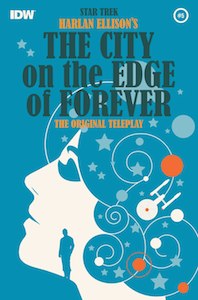
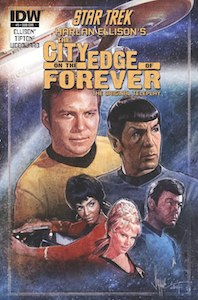
Cover: Art by Juan Ortiz, Subscription cover: Art by Paul Shipper
Star Trek: Harlan Ellison®’s Original City on the Edge of Forever Teleplay #5
written by Harlan Ellison, Scott Tipton and David Tipton, art by J.K. Woodward, letters by Neil Uyetake, edits by Chris Ryall, covers by Juan Ortiz and Paul Shipper
Story
Trooper, a disabled veteran, sells apples and pencils on a street corner. He knows everything that goes on in the neighborhood. Kirk needs information. He hires Trooper to keep an eye out for a man wearing peculiar clothes and carrying a weapon. Kirk is in love with Edith and distracted by what he knows about her future. Edith is upset and confused by Kirk’s self-absorption. Spock informs the captain that Trooper has located Beckwith. In a dark alley, they track down the fugitive, who draws a bead on Kirk. Trooper knocks Kirk aside and takes the full force of a phaser. Shocked by Trooper’s death, Kirk and Spock resume their search.
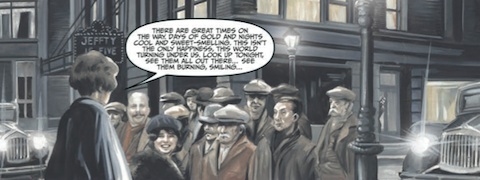
On a nearby street they find Edith speaking to a small group of people. She sees Kirk and waves, crossing the street to meet her beau. A truck bears down on her. Beckwith appears on the street and instinctively reaches out to stop Edith, but Spock pulls him aside. Edith must die.

Time resumes its shape. Kirk, Spock and Beckwith return through the vortex. Spock asks the Guardians about Trooper’s death. He counted, but not enough to alter the flow of time. Beckwith breaks free and charges into the vortex again, but into a fracture of his own making, locking himself in time. Back aboard the Enterprise, Kirk is trying to understand. Instead of the counsel of a first officer, Spock offers the advice and support of a friend.
Review
In this final issue, the story focuses on Kirk and his relationships. A brief but poignant connection to a disabled war veteran; a personal connection to his first officer; and the unexpected intimate connection to a woman, whose calling to lead others in hope, isn’t very different from his own calling as captain of a starship. The Tipton brothers, Scott and David, conclude their adaptation of Harlan Ellison’s original teleplay with grace and thought-provoking dialog. Even Beckwith has a moment of humanity that offers the kind of hope that Edith always looked for. While the details of this adaptation differ from the broadcast version of The City on the Edge of Forever, it’s clear that the spirit of Ellison’s story is what makes both versions memorable. I’m really pleased that IDW Publishing decided to publish this version of the story.
J.K. Woodward put an enormous amount of effort into his painted artwork, but it all seems to play out effortlessly while reading the comic. My compliments to Woodward for an outstanding job. The paperback-style covers by Juan Ortiz are very distinctive. My favorite is the cover for this final issue, which features Edith Keeler on a field of stars. Paul Shipper concludes his work on the mini-series with another striking movie-poster style cover featuring Kirk, Spock, McCoy, Uhura and Rand. Shipper’s work is also very distinctive. In case you missed it, he provided covers for IDW’s Khan mini-series last year. You can learn more about Paul Shipper and his art in an interesting Visionary Trek podcast, Holodeck Issue 45.
Put simply, I think this mini-series is a candidate for IDW Publishing’s best product of 2014, and any year since they began publishing Star Trek comics in 2007. The very introspective story by Harlan Ellison, a tight script by Scott and David Tipton, with sensational painted artwork by J.K. Woodward, and distinctive covers by Juan Ortiz and Paul Shipper, make it a treasure for any Trekkie interested in good story-telling.
One last note. As you can see in the preview below, J.K. Woodward pays homage to Harlan Ellison by giving Trooper a familiar face. In the letter section of this issue, the editors advise readers to take a close look at every issue of the mini-series for the Easter eggs the artist has sprinkled throughout the story. If you haven’t been reading individual issues, you’ll be able to read the entire tale in the complete hardcover collection, coming January 2015.
Preview of City on the Edge of Forever #5
The final issue of Harlan Ellison’s original teleplay adaptation, City on the Edge of Forever #5, is available now at your local comic shop and online.
If you’re interested in a different comic book reading experience, you can learn more about the Madefire Motion Books edition of Harlan Ellison’s City on the Edge of Forever at www.Madefire.com.
Also available!
Look for part four of “The Q Gambit” at your local comic shop in Star Trek #38 and watch for TrekMovie’s review of this issue.
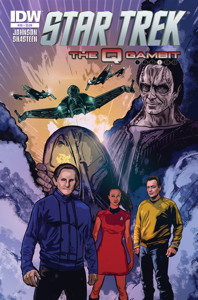
Star Trek #38, cover art by Tony Shasteen
Coming soon to a local comic shop near you!
Next up from IDW Publishing is part five of the ongoing story arc “The Q Gambit” and John Byrne presents Mudd, Harry Mudd.
Star Trek #39, cover art by Tony Shasteen; New Visions #4, photocomic by John Byrne
You can pre-order Star Trek comics at a discount from Things From Another World, just click on the banner.
But wait! There’s more for your eyeballs…
No matter how it’s told, The City on the Edge of Forever is arguably the most popular episode of the original television series, and has inspired more than comic book writers and artists. It doesn’t take much effort to find artwork like these posters, created by fans to celebrate the episode. If you know of more work like this, please post links in the comments.

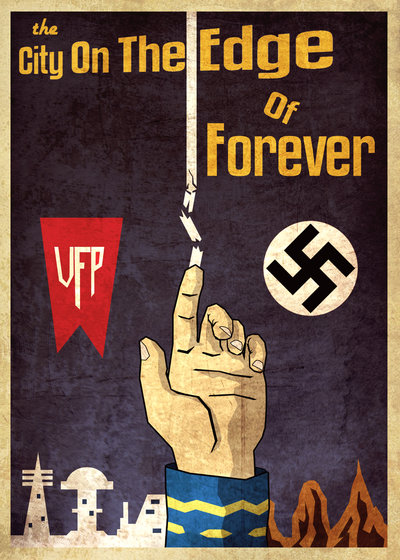
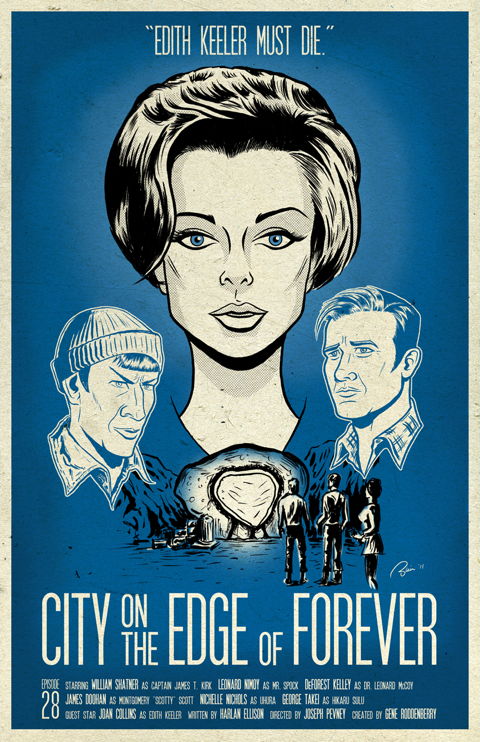


For the international set
The fotonovel adaptation of The City on the Edge of Forever was published in several languages. Here are cover scans of the Spanish and German editions. Other translations include Dutch and Japanese.
The main characters
Spock, Trooper, and Kirk. Where’s Edith? TrekMovie staff would like to wish Mr. Ellison a speedy recovery and return to writing.
Mark Martinez is an obsessive-compulsive Star Trek comics reader and collector. You can visit his website, the Star Trek Comics Checklist for more than you ever needed to know about Star Trek comics.








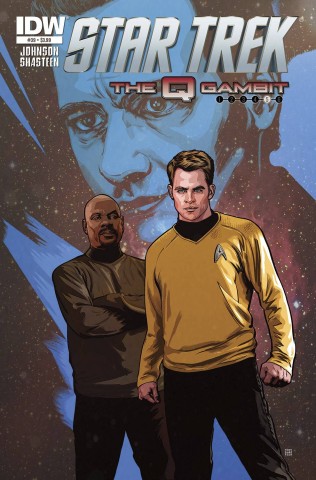
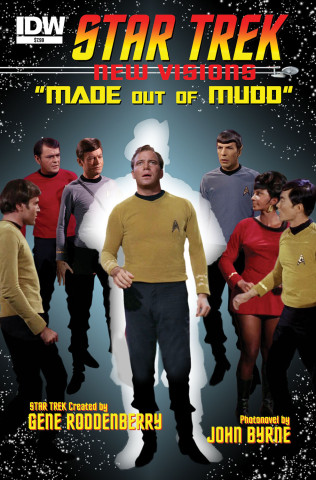

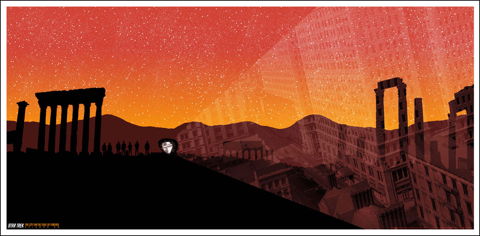
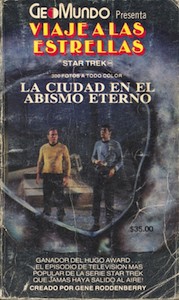


Amazing Art!
I always wondered about the soup kitchen guy who accidentally vaporized himself with McCoy’s phaser. Wouldn’t it be funny if Trooper, had he lived, made Edith’s death unnecessary? Let’s say he got back on his feet and worked with Edith in the soup kitchen, they fall in love and get married, and have kids which alters the amount of time she has to pursue her peace movement. Instead her contribution to history leads to the founding of the UN.
On the other hand, why didn’t Kirk and Spock just take Edith back to the future with them like they did the whale biologist from TVH, whose sudden disappearance from the 20th century didn’t seem to impact anything. Kirk could have restored time and had the greatest love of his life all with that one action.
What a great story this episode has become in both versions. It would be wonderful to have this episode in regular animation or CGI and use the original actors that are still alive to voice the project. Just think of adding something like this to the history of Star Trek….It boggles the mind..
Agreed – wonderful artwork. One of the men in the crowd that Edith is speaking to, the second guy on the right, sure looks like Roger C. Carmel’s Harry Mudd.
Star Trek – TOS was so under appreciated when it was first aired. Now, more than ever, it is a wonderful vehicle for morality plays…
Yeah the art is good. I wonder if Joan Collins has to be paid for the use of her likeness.
With all due respect to the fine job Mark Martinez has done in his coverage of this miniseries, forget about IDW’s adaptation of “The City on the Edge of Forever” being the best Trek comic of 2014, or even the best since 2007. It is, quite simply, the best thing with “Star Trek” in the title to come along in years. Decades, maybe.
J.K. Woodward told me that the publication of this final issue was delayed just so he could make sure that everything was as perfect as possible. For any fan of TOS who is emotionally invested in this story—and who isn’t?—the climax is everything, and while the staging of the scene has its roots in Joe Pevney’s fine direction of the aired version, Woodward makes it entirely his own. Our last look at Edith Keeler, reproduced above, is just heartbreaking.
The highest compliment I can pay to this version of “City” is that the characters of Trooper and Beckwith now seem as “real” to me as any of TOS’ often vivid and memorable guest-star appearances. Not bad for a little paper and ink, and quite a legacy for everyone involved. I think it will endure, just as the aired version has, for many, many years to come.
#2 “On the other hand, why didn’t Kirk and Spock just take Edith back to the future with them like they did the whale biologist from TVH, whose sudden disappearance from the 20th century didn’t seem to impact anything. Kirk could have restored time and had the greatest love of his life all with that one action.”
THINK ABOUT THAT; REALLY think about it. Besides the fact that such scenarios weren’t dreamt of back when TOS was created [Gillian Taylor’s story was in the mid-1980’s), Harlan’s story needed more TRUE DRAMA to make it what it was. First, and most important, is what Edith would want. She herself stated she was “no do-gooder,” but WOW did she have compassion for humanity! No matter how enticing that prize would be (to see the future FOR REAL), Edith would not choose to go. Listen to Joan Collins’ back-story, the one she herself stated she created in her mind (on the 5-Captains’ DVD collection, where they interviewed her with Bill Shatner). She stated Edith felt it was ALL TOO IMPORTANT to be there at the 21st St. Mission to serve the down and out, the homeless, the ones who were needing a friend to … help. “LET ME HELP,” Edith said to Jim Kirk. No, going with Kirk to the future would never be in her character, no matter how much she and Jim Kirk were in love: her love for humanity of the Depression era would win out, which makes this story all the more dramatic and tragic on Edith’s part.
No, having Edith go to the 23rd Century is far too easy an ending, and one that would never have made ‘City arguably the best ‘Trek story filmed to date, at least of TOS. Mr. Ellison’s ending is better (even after his story was re-written for the actual Desilu Studio shoot), from a truly DRAMATIC perspective, and that’s what makes the best story, including and most especially in Star Trek.
@ 8 Rhett Coates–
With respect, you’re overthinking this. In both versions of the story it’s made pretty clear that the only way Kirk and Spock will be returned to their own time was by setting history back on its proper course (i.e. allowing Keeler to die in her proper time). Kirk didn’t have a remote control in his pocket to request their recall to the future, let alone bringing a passenger. Of course, if Kirk had had a ship capable of time travel at his disposal he might have managed to fake Keeler’s death and bring her home (and maybe take along Clark Gable just for kicks), but that wasn’t the scenario in “City.”
(Incidentally, Nicholas Meyer didn’t care for the whole idea of bringing Gillian Taylor to the 23rd century in THE VOYAGE HOME, seeing it as wish-fulfillment fan service. But it works okay with the light-hearted nature of that particular film.)
The only way Edith Keeler could have logically come back was through the nexus and it would have made Kirk’s realizing she was not real all the more bittersweet. It also would have lifted Generations into a more dramatic film. Instead of a cabin in the mountains it could have been 30’s New York. I imagine Joan Collins would have considered reprising the role
@9. Michael Hall,
“In both versions of the story it’s made pretty clear that the only way Kirk and Spock will be returned to their own time was by setting history back on its proper course… Kirk didn’t have a remote control in his pocket to request their recall to the future, let alone bringing a passenger.”
My argument @2 above is mostly facetious and is typical of the nit-picking possible, and is practiced with Star Trek. City is typical TOS fare, in that the drama takes priority over explaining every little detail, something arguably TNG sacrificed with empty technobabble.
We could debate how the Guardian works all day, but the fact is its full of logical holes, and we’re not given nearly enough information to deduce anything conclusive. I mean, how exactly did Kirk, Spock and Bones return? Did a portal open right in front of them as soon as Edith’s body was beyond revival? Or did they just change back into their uniforms first and have a cup of coffee at the mission before leisurely returning via a portal that just opened in front of them? I mean they were seen leaping back through it in their uniforms? Did the Guardian re-dress them in transit through time? And you could go on and on like that.
But none of that serves the story. The whole reason I brought this up in the first place, is because I like that Ellison addresses the death of the homeless man. He MATTERED, but not enough to alter the flow of time. That was a concept worthy of exploration, but I suppose doesn’t serve the overall drama, and forces the audience into an existential fog mid-story.
However, as long as you bring it up … Edith had to die, did the Guardian NEED blood? Or could she exit the timeline with them? Let’s assume she could have … Merely changing the course of Edith’s life might have removed her importance from history. Why couldn’t Edith have changed focus with the right influences? She was smart, it seemed Kirk was on the precipice of revealing it all to her. Once he demonstrated that she had to take herself out of the timeline, and she agreed, then history would have theoretically been restored, and perhaps Edith could have left with him. I’m not arguing the drama. Just the logic. The fact that a homeless man died who did not die before, proves that history was not restored. In fact Kirk and Spock’s presence quite likely altered history in some minor way … Taking a job away from someone who would have had it, had Kirk and Spock not shown up, etc. So once you go down that road, the. Truly anything could have happened. Would it make the story better? No. It would have made it worse.
I guess my point is, let’s see if we can divorce ourselves from justifying a character’s behavior by explaining the macguffins, and accept these are fictional characters who are motivated by the most dramatic events to tell a compelling story.
Most TOS fans think of “City on the Edge of Forever” as the best TOS episode ever. I loved it when I was in my teens, but when I rewatched it at 55, I was less impressed. I think it’s good, don’t get me wrong, but I didn’t really believe that Kirk could fall in love with Edith Keeler, and if Kirk isn’t in love with her, then gosh, it’s an awful shame that they have to let such a nice woman die, but it’s not the great tragedy that it would otherwise be.
It’s not that I think Ms. Keeler isn’t loveable; of course she is. She’s kind and smart and progressive (and gorgeous), and that all seems great. What I didn’t buy was Kirk — I didn’t think Kirk had the emotional ROOM to fall in love with anyone, no matter how wonderful.
While Kirk is stuck in the past, he’s frantically trying to keep history from unraveling. The entire future rides on Kirk’s and Spock’s shoulders, and everyone they have ever loved and all that they have ever known will cease to exist unless they can right things. Furthermore, Kirk is stuck in the past with a Vulcan. If the wrong person sees Spock without his cap, they’ll take him away to question … or to dissect.
Kirk has lost his ship, his co-workers, his family, his world, and he’s in danger of losing the one person he’s brought with him. With all that on his mind, I don’t care how nice Edith Keeler is, it just seems as if his attention and his emotions would both be fully occupied elsewhere.
I realize that this is a minority point of view. :-) It wasn’t one that I held in my teens, but my middle-aged self has a different perspective. It’s still a good episode, even if one doesn’t believe in Kirk’s love for Edith, but it’s no longer grand tragedy, so it doesn’t quite achieve best-ever status. (To me, the best episode of TOS is “Amok Time.”)
I’ll be interested to check out this alternate version of “City,” to see if I find Kirk’s love for Edith a bit more believable in this version.
10. Brent
You almost had me crying at that possiblility.
12. Corylea
Good points about the plausibility of Kirk wanting Edith so desparately., However, was it ever mentioned how long Kirk and Spock waited for Bones. It seemed like the story intimated that they stayed for months. Was’nt it in the espisode “All Our Yesterdays” where Spock mentioned that he was loosing his Logical control over his emotions as his fellow Vulcans were probably a savage race at the time he me Zarabeth. This added emotional baggage seemed to push Spock into a more emotional stateEspecially when it came to defending his claim on Zarabeth when McCoy confronts him about searching again for the portal to leave the frozen world.
Perhaps this is another meme that Trek seems to hint about from time to time.
When you enter the past, your thoughts and emotions become subjective to the time you are living.
It’s not a strech for me to imagine Kirk wanting to live in that simplier time – away from Starfleet and safe with his new Love – Edith.
@ 11 Curious Cadet —
Thanks for the thoughtful response. I think the idea was that, until the fabric of history had been restored, there was no “future” (at least none they would recognize) for Kirk and Spock to return to. The Guardian wasn’t demanding some kind of ‘blood sacrifice’ in Edith’s death, or rewarding our heroes for succeeding in their mission by sending them home–it was just returning them to their proper place in time, now (whatever that word would mean in this context) that time itself had returned to its original (again, whatever that means) shape.
(This does suggest an interesting alternative story, albeit one far outside the scope of commercial ’60s television. Instead of allowing Edith to die, Kirk takes her into his confidence about his real identity–not a hard sell, given his knowledge of future history and the presence of Spock–and implores her to lay low, continue her good works but forsake the actions that will change history. Life goes on for the next dozen years, Kirk and Spock adjusting to their new lives under primitive circumstances, and Kirk and Edith grow ever-closer. Finally, we get Pearl Harbor, the Axis declares war on the United States, and Keeler’s pacifist vision becomes moot, at which time Kirk and Spock are returned to their own time, the Enterprise captain now separated from his one true love by a gulf of centuries. Almost as tragic an outcome, in its way, as the one we got.)
Though the time travel in both versions is riddled with paradoxes and inconsistencies, I think Ellison’s version works harder to make the scenario more plausible–and yes, he spares us the absurdity of having our heroes return to the present in uniform (a decision probably more due the exigencies of TV production than anything else).
@ 12 Corylea —
Well, to each his own. TV characters are “motivated” to do whatever the writer wants them to do, and while you might be right that it’s unrealistic for Kirk to have fallen in love under such circumstances, stranger things have happened, and for me it’s not a deal-breaker. Why, just this week a notorious, insane mass murderer from the Sixties got himself hitched, something I haven’t managed to do in five decades. And I’m a much nicer person than he is. :-)
I think you’d find that the Ellison version of the romance is more mature and dimensional than what was portrayed on air–Edith is no saint, but a woman who lends her considerable strength to others and yet confesses to Kirk at one point that she’s on the verge of losing her own hope. I don’t know if that would satisfy your reservations with the story or not, and in any case, I love the relationship even in the televised episode.
I agree with#12 it dose not feel right for kirk to fall in love and so quickly now maybe if they had been their longer say a few years! !!
As for taken Edith with them I thought that for a long time and then it hit me just, any action other than her death would change the timeline, either in the past or the future, if she had gone with kirk to the future kirk may have left starfleet so voyager probe would of destroyed earth or no peace with the klingons or khan hell bent on revenge with kirk users the weapon to kill edith and destroy earth or wherever they are, the guardian see all of time
Loved the comic book version however I don’t feel it would of worked in the program, drug dealers on the enterprise! ! Plus a ramdon crew member where the emotional hook for both viewers and kirk? Yes the scene where McCoy injection himself is painful to watch as it’s so badley done as well as the transporting down to the surface, as for the guardian’s being giant people how cool is that, however given the budget dose anyone think they could of pulled it off in the 1960s? Plus more cash spent on guests stars and even more cash and time spent of the alter enterprise now if it was a two parter great however would we still of had the mirror mirror story!
I would love to see other stories that were changed for whatever reasons this could be a fun alt star trek comic like what marvel do with the what if
@12 Corylea,
“While Kirk is stuck in the past…With all that on his mind, I don’t care how nice Edith Keeler is, it just seems as if his attention and his emotions would both be fully occupied elsewhere.”
One thing I think you could be reacting to is just how much time passed while they were “stuck” back in time. I don’t recall if we were given a specific time frame or not, but regardless, it’s hard to adequately convey the passage of time in a one-hour episode. For my part, I always saw it as a significant amount of time passing, and that can explain how even the most focused person could be distracted. Spock had his work cut out for him, but Kirk had very little to do but earn a living for them, and wait. And in walks Edith who not only gives Kirk something to do when he’s not working, but captivates him with her personality. Personally I could never imagine how anyone could be captivated by Joan Collins, but to each his own. Combine that with a significant amount of time for the relationship to develop, and acclimating to the past, forgetting the life he left behind to some extent, and it starts to make sense. It’s not that dissimilar to Picard’s journey in Inner Light.
And if that’s not enough, there’s Kirk himself. He’s a man of great passions. This isn’t the first woman Kirk has fallen in love with. I’ve forgotten the one Spock had to make him “forget” via a mind-meld. So given those two set of circumstances, I don’t think it’s such a stretch that Kirk actually fell in love with Edith. But this is one of those episodes that would have made a better two parter … The first ending with Kirk and Spock trapped in the past, just after Spock’s equipment completely shorted out. That would have given us more time to watch them struggle, perhaps years, waiting for McCoy to return and Kirk’s relationship develop with Edith. It would have also been fun to watch Spock deal with this culture directly. The Stargate movie Continuum, where Mitchell had to return 10 years prior to the pivotal change in history, always reminded me of what should have happened in City. But alas that wasn’t the nature of TOS.
# 14. pilotfred – November 20, 2014
“… as for the guardian’s being giant people how cool is that, however given the budget dose anyone think they could of pulled it off in the 1960s?” — pilotfred
It is a matter of mystery to me why people keep focusing on the giants as some exorbitant fx cost in the 1960s?
Irwin Allen, their competition in sf TV, didn’t think so, and peppered his series with giants in that decade. LOST IN SPACE featured them in their unaired pilot which they recycled into their 1st season episode, THERE WERE GIANTS IN THE EARTH, and later that same season they gave Dr. Smith and the Bloop the extra large treatment in THE OASIS. In TRIP THROUGH THE ROBOT, that character was giant sized.
Allen was so enamored of the concept that when CBS cut LOST IN SPACE’s 4th season budget, he cancelled that show and created LAND OF THE GIANTS.
Since Ellison had already written a script for Allen’s VOYAGE TO THE BOTTOM OF THE SEA series, he was very likely well aware of what a non-issue giants would have been.
Oh, and by the way there were giants in Trek’s THE GALILEO 7 as well. They were so big they were able to hinder the shuttle’s takeoff.
I prefer the episode as filmed, hokey lines and all.
“The fact that a homeless man died who did not die before, proves that history was not restored.”
I always wondered why they put that scene in there. To show consequences of having the future guys around? And, one could argue that a homeless guy during the depression might have dissappeared or have died anyway, nobody would have noticed and it wouldn’t have made the slightest impact on history, sadly. Actually, true now too, even more sadly.
I think in the episode Kirk had feelings for her, regardless of how long he’d known her. It may not yet have been “Let’s get married” love, but even if it was just a friendship, imagine knowing this really great person and then realizing that they have to die. That alone would magnify feelings.
So why’d he hang out with her casually when he knew she had to die?
I think that it is feasible that Kirk could have “fallen in love”. It is not an either/or situation that some people seem to think. Kirk has concern, affection, love for Spock and his ship and crew, which is one kind of love, and then there is another kind of love that Kirk could feel for a woman like Edith Keeler. They are not mutually exclusive.
The fact is, in the TV episode, Kirk did forsake his love and allow Edith to die in order to restore everything, to the sorrow of himself and Dr McCoy and to the mystification of Dr McCoy, until all could be explained.
In the beginning, neither Kirk or Spock knew that Edith Keeler had to die, however, by the time, it was revealed, Kirk had fallen in love.
@16. Disinvited,
“Oh, and by the way there were giants in Trek’s THE GALILEO 7 as well. They were so big they were able to hinder the shuttle’s takeoff.”
Apollo was also a giant in Who Mourns for Adonis?. Considering the rest of the episode took place in the 20th century on the studio backlot, it’s hard to imagine exactly where the budget problems arose … maybe Joan Collins salary, or Ellisons?
Marja,
“The fact is, in the TV episode, Kirk did forsake his love and allow Edith to die in order to restore everything, to the sorrow of himself and Dr McCoy and to the mystification of Dr McCoy, until all could be explained.”
You may be intrigued to know that the story does not conclude that way in Ellison’s original draft. At the moment of decision, faced with the loss of someone who has come to mean so much to him, Kirk cannot act. The Enterprise, his crew, the future itself be damned–he will sacrifice everything for her! It is Spock, logical and rational, who prevents Edith Keeler’s life from being saved, thus restoring the flow of time.
(Interestingly enough, this “love trumps even the future” theme, which evidently meant a great deal to Ellison, had been explored several years before on an episode of “The Outer Limits” featuring, of all people, Grace Lee Whitney.)
Though I have long since concluded that Ellison’s version is by far the richer meal, I still believe that the producers made the right call in this very important respect, at least. Not because our stalwart Captain “wouldn’t act like that”–as Ellison points out, who knows how someone will react when pushed to that ultimate confrontation with himself?–but because the scene as aired is much more potent dramatically. That image of Kirk, knowing what must come next, throwing himself blindly in McCoy’s way, is a signal moment in 20th century American television, almost worth all of the artistic compromises it took to get there. I’d be the last to second-guess the instincts of any artist, let alone one as erratically brilliant as Harlan Ellison, but it may just be the case that the Trek producers had a clearer understanding of the core essence of this story’s power than the author did himself.
Giants? Please. The drama in “The Galileo Seven” is very successful; the depiction of the giant creatures (we only see one) not so much. (And that Cyclops in the LIS pilot? Pure camp.) Ellison’s script required the depiction of at least a half-dozen 9 foot-tall “Guardians of Forever,” who in addition to the process shot visual effects would have all required elaborate makeup and costuming. I think Bob Justman, whose production and budgetary expertise on Trek and “The Outer Limits” were just short of legendary, was in a better position to decide what was affordable than people second-guessing him almost fifty years after the fact.
#22. Michael Hall – November 21, 2014
“(And that Cyclops in the LIS pilot? Pure camp.)” — Michael Hall
And so was the ape mask in LIS’ FUGITIVES IN SPACE but that didn’t prevent it from being used for a far more dramatic purpose in the motion picture, PLANET OF THE APES, in the same decade, i.e. I don’t get the connection you are trying to draw. Allen might have leaned too much on his fx but he did go on to build a 2 season series around giants in the decade in question and as was par for his course on TV he managed to turn out one or two episodes that weren’t camp with 9 or so giants looming about.
And there’s no second guessing: 1950s and 1960’s SF and Fantasy TV productions had done giants and were doing them (in some cases to great dramatic effect.) Ellison was aware of it. Justman was aware what his immediate professional competition had done in the year prior. He was just wrong in this one particular instance about the cost being unmanageable on a 1960’s TV production budget. The one thing that emerged over the years on Trek production was that it was done by humans who were not infallible but put out a pretty amazing product considering all their and the nature of 1960s’ television network production limitations.
@22. Michael Hall,
“Ellison’s script required the depiction of at least a half-dozen 9 foot-tall “Guardians of Forever,” who in addition to the process shot visual effects would have all required elaborate makeup and costuming.”
I don’t recall the specifics of the Giants, were they supposed to all speak? If so, I can guarantee the cost of hiring 9 principal actors was the most significant factor in depicting them.
Either way, I think the giants are hokey. I like the idea of a device left on automatic, long since abandoned by its creators.
@ 24 Disinvited —
“Justman was aware what his immediate professional competition had done in the year prior. He was just wrong in this one particular instance about the cost being unmanageable on a 1960’s TV production budget.”
Well, who knows? Based on Justman’s disavowal of top-tier TOS episodes like “The Devil in the Dark” and “The Trouble With Tribbles,” let lone his famous six-page memo where he details everything he thought was wrong with “City” (only to openly regret the loss of Ellison’s poetic voice in the final draft after getting the changes he asked for), I certainly don’t consider his judgement infallible. Maybe he was wrong about the price of Ellison’s giant Guardians being prohibitive. But I’d sure like to know what sort of production expertise, let alone historical knowledge of how resources were managed on each of the series you mention, allows you to make such a definitive judgement yourself. Put it this way: I have a lot more confidence that Justman was correct than in your ability–or mine for that matter–to properly evaluate such things a half-century after the fact.
#26. Michael Hall – November 22, 2014
” Put it this way: I have a lot more confidence that Justman was correct than in your ability–or mine for that matter–to properly evaluate such things a half-century after the fact.” — Michael Hall
I’m not sure what timbre these 50 years of yours add to the discussion but for the record, I was alive and watching these episodes and shows when they first premiered and making the exact same comparative evaluations back then twixt sf TV productions.
And my only point is Justman’s claim in specifics to giants seems suspect as other shows (TWILIGHT ZONE, I DREAM OF JEANIE, BEWITCHED, LOST IN SPACE, etc.) managed the perspective difference between wee and BIG without the exasperation that he musters for it which suggested to me back then and now that there was a bit of lack of creative imagination in that regards. Especially given that Justman’s show production introduced giants. And as I recall Ruk the android certainly gave the impression of a giant — 9 feet and al l– as well.
City stands as a great Trek moment that, sadly was never officially addressed subsequently. In Battlestations! Kirk had a ship called Edith Keeler and in Vonda McIntyre’s STIV adaptation, McCoy and Kirk have a Guardian-related row about the plan to travel to the 1980s.
City, in a sense, I see as the first true Trek movie. It stands alone as great sci-fi with a reach beyond just traditional Trek. Had they replaced ‘Antonia’ with ‘Edith’ in Generations, the film might have rung more true.
“City, in a sense, I see as the first true Trek movie. It stands alone as great sci-fi with a reach beyond just traditional Trek.”
Well, for my money “The Menagerie” still stands as the first, and best, Trek movie by far, and for the same reasons you cite.
“Had they replaced ‘Antonia’ with ‘Edith’ in Generations, the film might have rung more true.”
Gods, yes. I’ve often thought the same thing myself. I can’t imagine why they didn’t, either. Ron Moore is a huge TOS fan, well aware of “City’s” importance to the Trek mythos. General audiences wouldn’t have noticed or cared, but fans would have gotten the reference instantly. Just a total no-brainer.
“Had they replaced ‘Antonia’ with ‘Edith’ in Generations, the film might have rung more true.” I have thought that for years. Picture Picard walking on to a New York street in the 30’s and seeing Kirk coming up the street with a bag of groceries. A real conversation with Edith Keeler welcoming Picard and the real pain when Kirk realizes she is just an illusion. . A little more in the budget for a Joan Collins cameo
I always wish they’d put a mention about Carol Marcus being killed in rogue klingon attacks (denied by the klingons) in the preamble to Star Trek VI — prob too much too explain in a movie… but the sense of Kirk’s anger being rawer (and them all expecting that briefing to be about a war with the klingons) would have given their “but we hate Klingons” a little more context.
I mention this as I almost wonder whether Marcus would have been a better mention in Generations. “Carol and I were going to try again — it might not have worked, but we thought we owed it to each other to try, and David” (too much, maybe). As opposed to Antonia, which was invented by Shatner (along with the great dane and the horses).
@31 Jack,
“I almost wonder whether Marcus would have been a better mention in Generations”
ANY character from Star Trek would be better than Antonia. How about the mysterious Ruth from “Shore Leave”? Or Miramanee from “Paradise Syndrome”? Janet Wallace from “The Deadly Years”, Areel from “Court Martial”, or even Rayna from “Requiem for Methuselah”? Any one of those would have been a better choice … But certainly Marcus was already mentioned as a love interest in the film series for anyone following, and I don’t believe any others were. Given Picard’s fantasy, and Kirk’s stated regrets, raising a toddler David together with Marcus would have carried much more meaning. Indeed, what a perfect way to show the timelessness of the Nexus … One minute Shatner is holding his toddler, the next he’s throwing a football with the same child as an adolescent, and later riding horses with a teenage David, or rock climbing (isn’t it interesting that Picard has all the same passions as Kirk?).
I suspect part of it is that they were trying to depict a relationship that tied into Shatner’s 60 year old appearance. Going back to David’s birth with Marcus would have suggested a much younger Shatner … Though I don’t know why, as they certainly didn’t worry about that with Picard.
#31 – “I mention this as I almost wonder whether Marcus would have been a better mention in Generations. “Carol and I were going to try again — it might not have worked, but we thought we owed it to each other to try, and David” (too much, maybe). As opposed to Antonia, which was invented by Shatner (along with the great dane and the horses).”
No, not too much. That could have been good and rung true, along with the great dane and the horses. I like the fact that Shatner saw Kirk as being an animal lover as well.
Perhaps the idea of Kirk shown being with Carol and David while he was in the Nexus did occur, however, unfortunately the actor who played David Marcus died soon after the release of Star Trek III…:(
@18
About the homeless guy who died: When he destroyed himself with McCoy’s phaser, he also destroyed the phaser. So maybe they were making sure that twenty-third-century technology wasn’t left in the past. Of course, they could have omitted the homeless guy and just had McCoy keep the phaser, with the implication that he still had it on him when he returned to the future, but maybe the writers were thinking that it was best to effectively disarm the wacked-out McCoy, lest he wreak havoc with the phaser against the “Killers!” and “Assassins”!
#34 – Actually, Merritt Butrick, who played David in “Trek”s II and III, was in “Next Gen”‘s “Symbiosis”, a first season episode. He died in March of 1989.